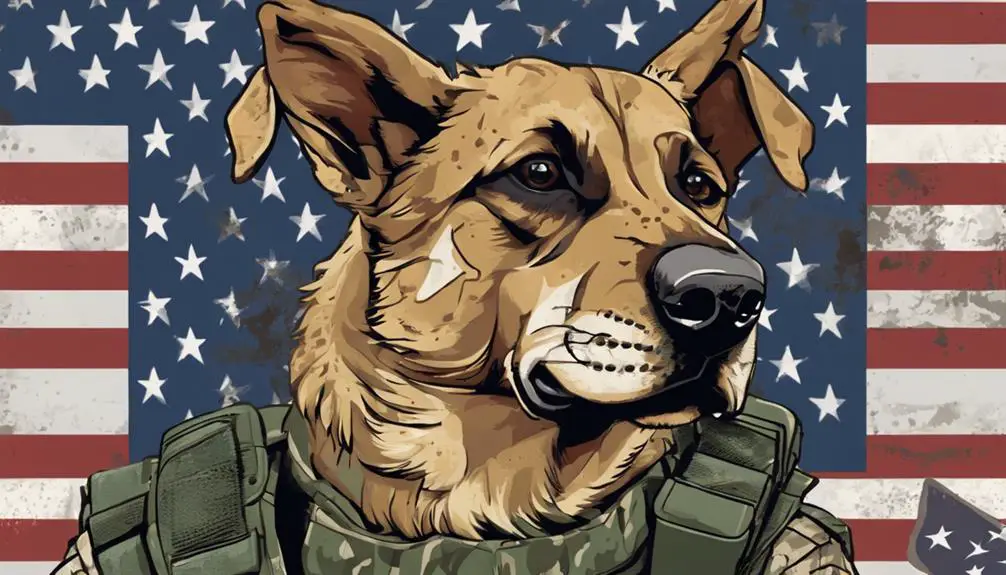You're about to enter a world where 'narc' means more than just a bad guy, and 'expo' can save lives. Army dog military slang originated in World War I as a necessity for clear communication. Today, handlers use abbreviations, acronyms, and code words to convey instructions to their canine partners. You'll hear terms like 'narc' for narcotics detection, 'pat' for patrol, and 'expo' for explosive detection dogs. As you explore this world of military working dogs, you'll discover more surprising terms and phrases that reveal the deep bond between handlers and their furry friends – and that's just the beginning.
Origins of Army Dog Lingo
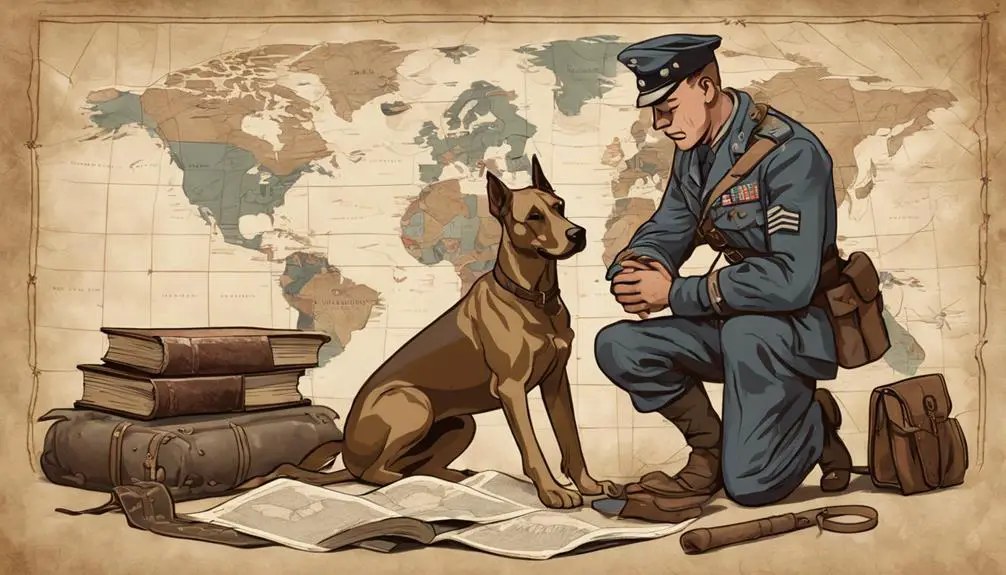
You've probably wondered where the colorful language of Army dogs originated, and the answer lies in the early days of the US military. The Historical Evolution of Army dog lingo dates back to World War I, when the US military first began using dogs in combat. During this time, soldiers and dog handlers developed a unique language to communicate effectively in high-stress situations. This language was born out of necessity, as clear communication was essential in the heat of battle.
The Linguistic Roots of Army dog lingo are deeply rooted in military jargon and colloquialisms. Handlers and trainers used abbreviations, acronyms, and code words to convey complex commands and instructions quickly. This specialized language allowed them to work efficiently, even in the chaos of war.
Over time, this language evolved and spread throughout the military, becoming an integral part of Army dog culture. Today, this distinct language continues to play an important role in the training and deployment of Army dogs, facilitating seamless communication between handlers and their canine partners.
Basic Commands and Hand Signals
As you learn the language of Army dogs, mastering basic commands and hand signals is a critical step in establishing a strong bond with your canine partner. These fundamental directives enable effective Canine Communication, ensuring you and your dog work in harmony.
By using Silent Directives, you'll convey instructions without alerting others to your intentions.
Basic commands include 'sit,' 'stay,' 'come,' and 'heal,' which are essential for everyday obedience and operational scenarios. Hand signals accompany these verbal cues, providing a visual reinforcement of your commands.
For example, holding your hand out, palm facing your dog, signals 'stay.' A sweeping motion with your arm indicates 'come.' These non-verbal cues are particularly useful in high-stress environments where vocal commands may be compromised.
Mastering basic commands and hand signals takes practice, but it's essential for building trust and reliability with your canine partner. By integrating these Silent Directives into your training routine, you'll enhance your dog's responsiveness and strengthen your partnership.
Slang for Canine Capabilities
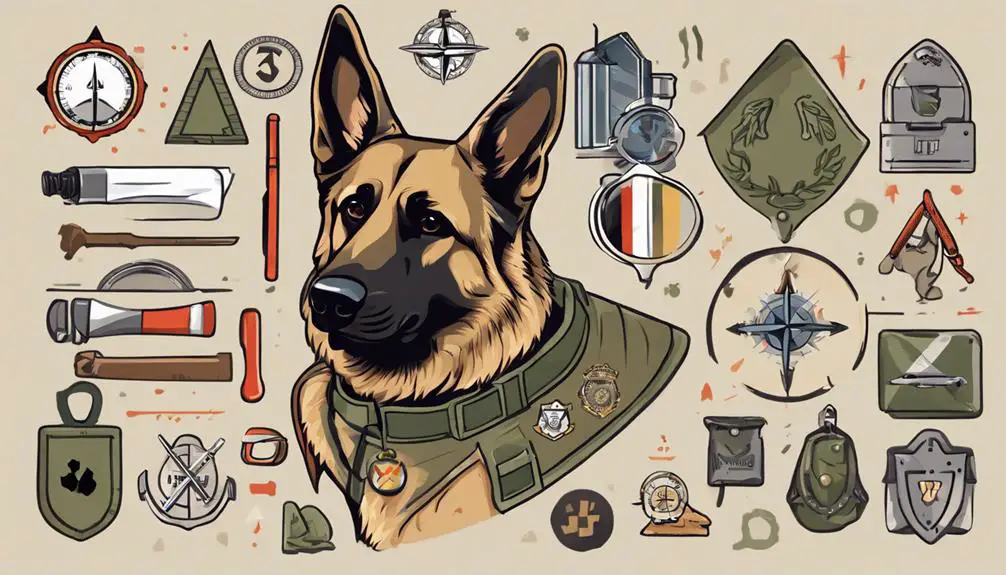
In the military, dog handlers use specific slang to explore a canine's capabilities, such as 'narc' for a dog trained to detect narcotics or 'pat' for a patrol dog. As you investigate into the world of army dog slang, you'll discover that each term is carefully chosen to convey a dog's strengths and specializations.
Here are some examples of slang used to describe a dog's capabilities:
- Sniffing Modes: Terms like 'passive' or 'active' describe a dog's sniffing style, with passive dogs indicating finds by sitting or lying down, and active dogs indicating finds by barking or running to the source.
- Breed Strengths: Certain breeds are better suited for specific tasks, with German Shepherds excelling in patrol work and Belgian Malinois in detection.
- Explosive Detection: Dogs trained to detect explosives are referred to as 'expo' dogs.
- Specialized Training: Dogs trained in specialized areas like arson detection or search and rescue have their own unique slang terms.
- Task-Oriented: Slang terms like 'narc' or 'pat' describe a dog's specific task or function within the military.
Emotional Support Dog Terms
Your understanding of army dog slang expands to emotional support dog terms, which highlight a different aspect of canine capabilities. These terms focus on the emotional bond between humans and dogs, showcasing the critical role canines play in providing comfort and solace.
Emotional support dogs, often referred to as ESAs, are trained to offer emotional comfort and companionship to individuals in need. They're not considered service animals, as they don't receive the same extensive training. Instead, their presence and affection provide a sense of calm and well-being.
The emotional bonding between humans and ESAs is remarkable. These dogs are often certified to assist individuals with mental health conditions, such as anxiety, PTSD, or depression. By providing emotional support, they help alleviate symptoms and improve overall mental health.
While they may not have the same level of training as service animals, ESAs are invaluable companions, offering a sense of comfort and security to those who need it most.
Military Working Dog Nicknames
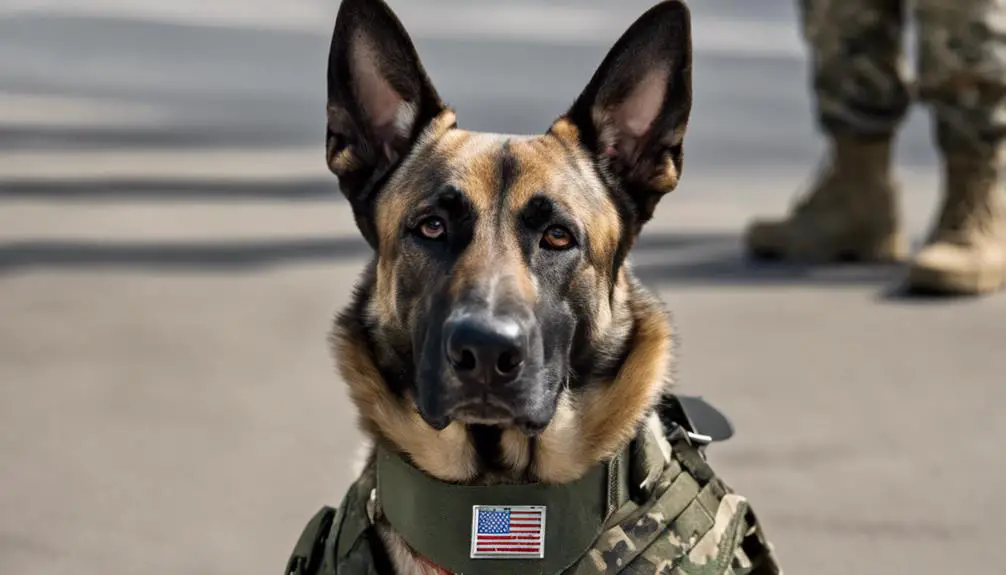
Military working dogs have earned a range of nicknames that reflect their skills, temperament, and the critical roles they play in supporting military operations. You might've heard some of these nicknames, but do you know what they mean?
Here are some examples:
- Warrior Wings: This nickname highlights the life-saving role that military working dogs play in combat zones, often providing a pivotal edge in detecting explosives or enemy forces.
- Furry Heroes: This nickname acknowledges the bravery and loyalty of these canine heroes, who risk their lives to protect their handlers and fellow soldiers.
- Nose: A nod to the incredible sense of smell that military working dogs possess, which is often essential in detecting explosives or narcotics.
- Paw-fficer: A playful take on the word 'officer,' reflecting the respect and admiration that handlers have for their canine partners.
- Battle Buddy: This nickname emphasizes the strong bond between a handler and their military working dog, who work together as a team in high-pressure situations.
These nicknames are a tribute to the important role that military working dogs play in modern warfare.
Common Handler Commands
As you work alongside your military working dog, you'll rely on a set of essential handler commands to communicate effectively and achieve your mission objectives. These commands are vital in establishing handler trust, ensuring your dog responds promptly and accurately to your instructions.
Clear and concise communication is key to success, and that's where command clarity comes in. You'll use commands like 'heel' to keep your dog by your side, 'stay' to maintain a safe distance, and 'come' to quickly recall your dog in high-pressure situations.
Other essential commands include 'search' to initiate a sweep, 'quiet' to calm your dog, and 'release' to permit your dog to engage or disengage. By mastering these commands, you'll build a strong foundation of trust and understanding with your military working dog, enabling you to work seamlessly together to accomplish your mission goals.
Medical Response Slang
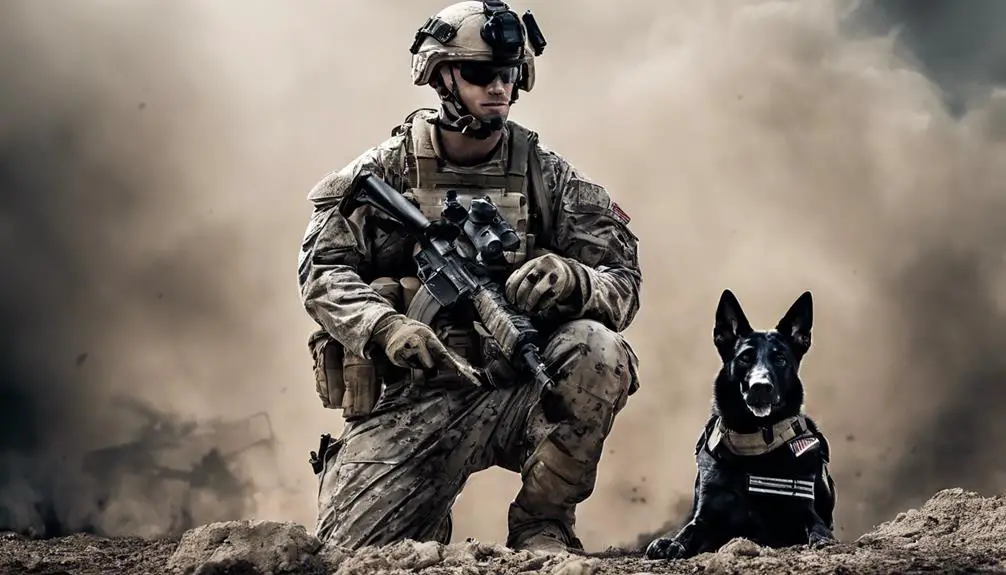
In high-stress medical response situations, you'll rely on a distinct set of slang terms to swiftly convey critical information and coordinate lifesaving efforts. As a medical responder, you'll need to quickly assess and communicate critical patient information to guarantee timely treatment and evacuation.
Here are some essential medical response slang terms to know:
- Triage Talk: Prioritizing patients based on severity of injury, with Red (immediate attention), Yellow ( delayed attention), and Green (minor injuries) designations.
- Wound Wisdom: Understanding the severity of wounds, such as GSW (gunshot wound) or BLS (basic life support) requirements.
- MEDEVAC: Medical evacuation, often via helicopter, to transport patients to higher-level care.
- RTD: Return to duty, indicating a patient is fit to rejoin their unit.
- MASCAL: Mass casualty, a situation where multiple patients require simultaneous treatment.
Familiarity with these terms will enable you to swiftly convey critical information, facilitating efficient and effective medical response efforts.
Playful Terms of Endearment
You'll often hear Army dog handlers using playful terms of endearment to address their canine partners, which not only strengthens their bond but also helps in high-pressure situations. These affectionate nicknames create a sense of camaraderie and trust, essential for successful missions.
Here are some common playful terms of endearment used by Army dog handlers:
| Term of Endearment | Meaning | Context |
|---|---|---|
| Furry Friend | A term of affection for a canine partner | Used in casual conversation |
| Battle Buddy | A term emphasizing the canine's role in combat | Used in high-pressure situations |
| Good Boy/Girl | A praise for a job well done | Used during training exercises |
| Buddy | A casual term for a canine partner | Used in everyday interactions |
| Hero | A term of admiration for a canine's bravery | Used during debriefing sessions |
These playful terms of endearment humanize the canine partner, acknowledging their importance in the team. By using these affectionate nicknames, handlers can build a stronger bond with their Furry Friend, ultimately leading to a more effective partnership on the battlefield.
Frequently Asked Questions
Can Any Breed of Dog Become a Military Working Dog?
Can any breed of dog become a military working dog?
Not quite. Breed selection plays a vital role in determining a dog's potential for military work. Genetic predisposition also plays a significant part, as certain breeds are naturally more inclined towards tasks like detection and protection.
While any dog can be trained, only a few breeds possess the innate abilities and traits necessary to excel in high-stress military environments.
How Long Does Military Dog Training Typically Take?
You're about to start on a fascinating journey, where the unbreakable bond between humans and canines is forged.
Typically, military dog training takes around 120 days to complete, but this timeframe can vary depending on the breed, temperament, and role.
The journey begins with Basic Obedience, where you'll teach your furry partner to sit, stay, and respond to commands.
As you progress, you'll delve into Advanced Training, honing skills like detection, tracking, and protection.
Do Military Dogs Receive Medals or Awards for Service?
You might wonder if military dogs receive medals or awards for their service.
The answer is yes! Military dogs can earn decorative honors and Canine commendations for their bravery and exceptional service.
These awards acknowledge their vital role in supporting troops and completing missions.
While not all military dogs receive awards, those that do are recognized for their outstanding contributions.
Can Military Dogs Be Adopted After Their Service?
As you explore the world of military service, you might wonder: can military dogs be adopted after their service?
The answer is yes! Once they retire, these heroes need a new lease on life. You can be a part of their journey by becoming a foster family, providing a temporary haven until they find their forever homes.
Organizations like Mission K9 Rescue and the US Military Working Dog Teams National Monument facilitate this process, helping our canine companions find a well-deserved happy ending.
Are Military Dogs Treated With the Same Respect as Human Soldiers?
You might wonder if military dogs receive the same respect as human soldiers. The answer is yes. These canine heroes are treated with dignity, earning rank privileges and enjoying emotional bonds with their handlers.
They're decorated for bravery, receive medical care, and even have their own memorial services. As valued members of the military team, they're honored for their sacrifices and contributions to national security.
Conclusion
As you navigate the world of military canines, remember that understanding their lingo is key to unleashing their full potential. Like a puzzle, each term and command fits together to create a cohesive unit, with handlers and dogs working in perfect harmony.
By speaking their language, you'll be well on your way to becoming a valuable asset to the team, and these remarkable animals will be by your side every step of the way.

